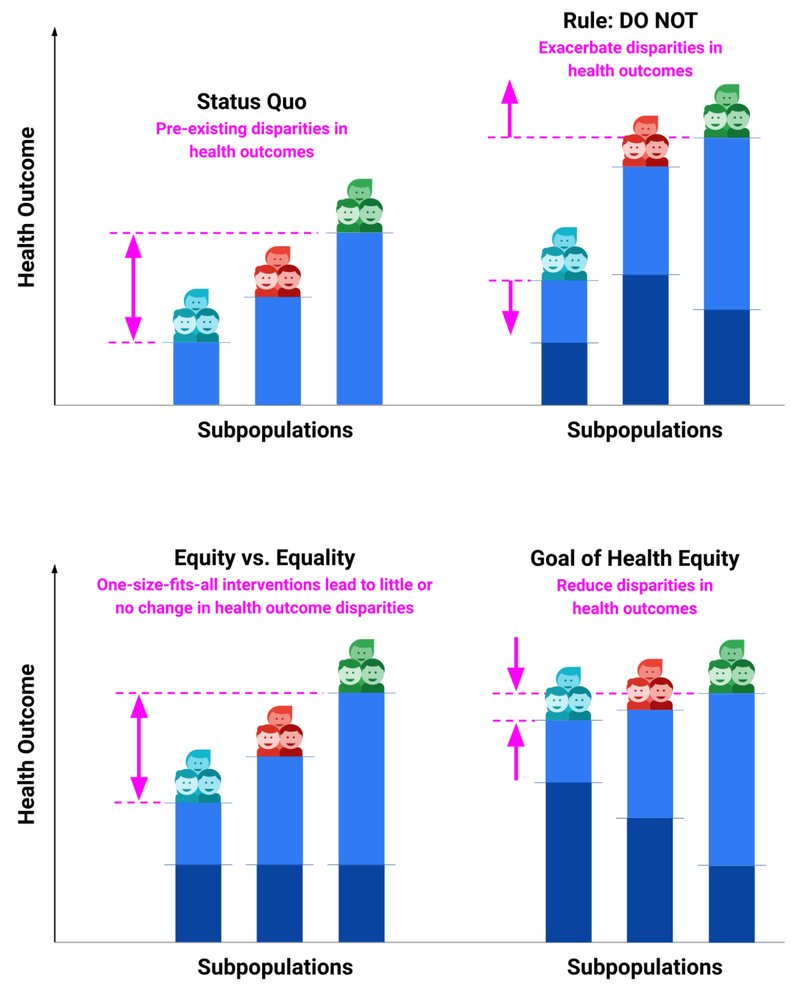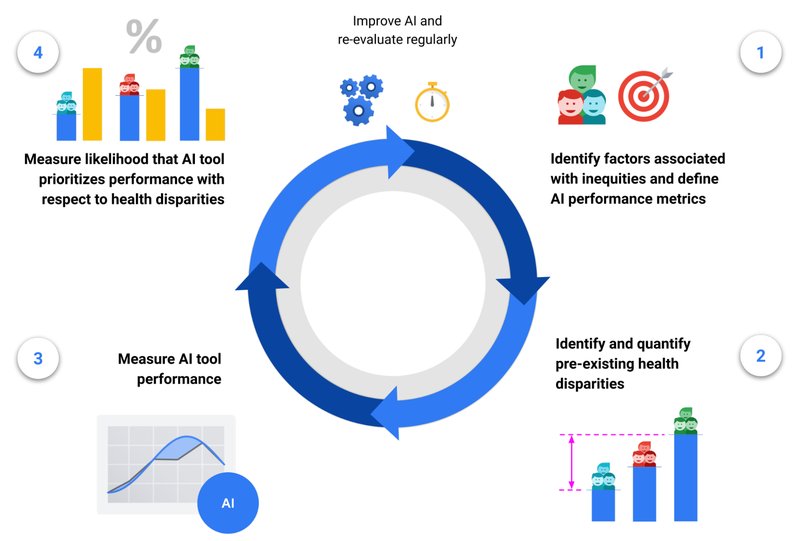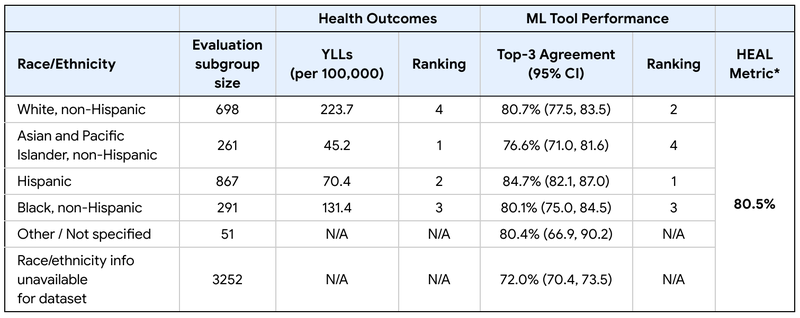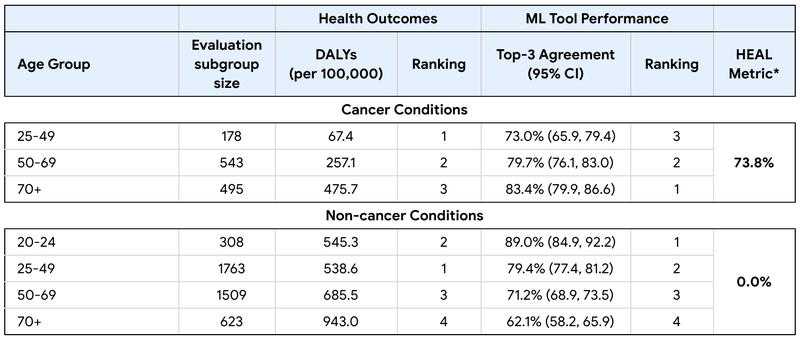[ad_1]
At present, we introduce Well being Fairness Evaluation of machine Studying efficiency (HEAL), a novel analysis framework designed to quantitatively assess whether or not the efficiency of an ML-based well being device is equitable. We suggest a 4-step course of for estimating the probability that an ML device performs higher for teams with, on common, worse well being outcomes as in comparison with different teams, with the purpose to tell enhancements that make well being AI applied sciences extra equitable.
Well being fairness is a significant societal concern worldwide with disparities having many causes. These sources embrace limitations in entry to healthcare, variations in medical therapy, and even elementary variations within the diagnostic expertise. In dermatology for instance, pores and skin most cancers outcomes are worse for populations reminiscent of minorities, these with decrease socioeconomic standing, or people with restricted healthcare entry. Whereas there’s nice promise in current advances in machine studying (ML) and synthetic intelligence (AI) to assist enhance healthcare, this transition from analysis to bedside should be accompanied by a cautious understanding of whether or not and the way they influence well being fairness.
Well being fairness is outlined by public well being organizations as equity of alternative for everybody to be as wholesome as potential. Importantly, fairness could also be completely different from equality. For instance, folks with higher boundaries to bettering their well being could require extra or completely different effort to expertise this honest alternative. Equally, fairness will not be equity as outlined within the AI for healthcare literature. Whereas AI equity usually strives for equal efficiency of the AI expertise throughout completely different affected person populations, this doesn’t middle the purpose of prioritizing efficiency with respect to pre-existing well being disparities.

Well being fairness issues. An intervention (e.g., an ML-based device, indicated in darkish blue) promotes well being fairness if it helps cut back current disparities in well being outcomes (indicated in lighter blue).
In “Well being Fairness Evaluation of machine Studying efficiency (HEAL): a framework and dermatology AI mannequin case examine”, printed in The Lancet eClinicalMedicine, we suggest a technique to quantitatively assess whether or not ML-based well being applied sciences carry out equitably. In different phrases, does the ML mannequin carry out nicely for these with the worst well being outcomes for the situation(s) the mannequin is supposed to deal with? This purpose anchors on the precept that well being fairness ought to prioritize and measure mannequin efficiency with respect to disparate well being outcomes, which can be as a result of quite a lot of elements that embrace structural inequities (e.g., demographic, social, cultural, political, financial, environmental and geographic).
The well being fairness framework (HEAL)
The HEAL framework proposes a 4-step course of to estimate the probability that an ML-based well being expertise performs equitably:
(1) Determine elements related to well being inequities and outline device efficiency metrics,
(2) Determine and quantify pre-existing well being disparities,
(3) Measure the efficiency of the device for every subpopulation,
(4) Measure the probability that the device prioritizes efficiency with respect to well being disparities.
The ultimate step’s output is termed the HEAL metric, which quantifies how anticorrelated the ML mannequin’s efficiency is with well being disparities. In different phrases, does the mannequin carry out higher with populations which have the more serious well being outcomes?
This 4-step course of is designed to tell enhancements for making ML mannequin efficiency extra equitable, and is supposed to be iterative and re-evaluated regularly. For instance, the provision of well being outcomes knowledge in step (2) can inform the selection of demographic elements and brackets in step (1), and the framework may be utilized once more with new datasets, fashions and populations.

Framework for Well being Fairness Evaluation of machine Studying efficiency (HEAL). Our tenet is to keep away from exacerbating well being inequities, and these steps assist us establish disparities and assess for inequitable mannequin efficiency to maneuver in direction of higher outcomes for all.
With this work, we take a step in direction of encouraging specific evaluation of the well being fairness issues of AI applied sciences, and encourage prioritization of efforts throughout mannequin improvement to scale back well being inequities for subpopulations uncovered to structural inequities that may precipitate disparate outcomes. We must always observe that the current framework doesn’t mannequin causal relationships and, due to this fact, can not quantify the precise influence a brand new expertise could have on decreasing well being consequence disparities. Nevertheless, the HEAL metric could assist establish alternatives for enchancment, the place the present efficiency will not be prioritized with respect to pre-existing well being disparities.
Case examine on a dermatology mannequin
As an illustrative case examine, we utilized the framework to a dermatology mannequin, which makes use of a convolutional neural community much like that described in prior work. This instance dermatology mannequin was skilled to categorise 288 pores and skin situations utilizing a improvement dataset of 29k instances. The enter to the mannequin consists of three images of a pores and skin concern together with demographic data and a quick structured medical historical past. The output consists of a ranked record of potential matching pores and skin situations.
Utilizing the HEAL framework, we evaluated this mannequin by assessing whether or not it prioritized efficiency with respect to pre-existing well being outcomes. The mannequin was designed to foretell potential dermatologic situations (from a listing of tons of) based mostly on images of a pores and skin concern and affected person metadata. Analysis of the mannequin is completed utilizing a top-3 settlement metric, which quantifies how usually the highest 3 output situations match the almost definitely situation as recommended by a dermatologist panel. The HEAL metric is computed by way of the anticorrelation of this top-3 settlement with well being consequence rankings.
We used a dataset of 5,420 teledermatology instances, enriched for range in age, intercourse and race/ethnicity, to retrospectively consider the mannequin’s HEAL metric. The dataset consisted of “store-and-forward” instances from sufferers of 20 years or older from main care suppliers within the USA and pores and skin most cancers clinics in Australia. Primarily based on a evaluate of the literature, we determined to discover race/ethnicity, intercourse and age as potential elements of inequity, and used sampling methods to make sure that our analysis dataset had enough illustration of all race/ethnicity, intercourse and age teams. To quantify pre-existing well being outcomes for every subgroup we relied on measurements from public databases endorsed by the World Well being Group, reminiscent of Years of Life Misplaced (YLLs) and Incapacity-Adjusted Life Years (DALYs; years of life misplaced plus years lived with incapacity).

HEAL metric for all dermatologic situations throughout race/ethnicity subpopulations, together with well being outcomes (YLLs per 100,000), mannequin efficiency (top-3 settlement), and rankings for well being outcomes and gear efficiency.(* Increased is healthier; measures the probability the mannequin performs equitably with respect to the axes on this desk.)

HEAL metric for all dermatologic situations throughout sexes, together with well being outcomes (DALYs per 100,000), mannequin efficiency (top-3 settlement), and rankings for well being outcomes and gear efficiency. (* As above.)
Our evaluation estimated that the mannequin was 80.5% prone to carry out equitably throughout race/ethnicity subgroups and 92.1% prone to carry out equitably throughout sexes.
Nevertheless, whereas the mannequin was prone to carry out equitably throughout age teams for most cancers situations particularly, we found that it had room for enchancment throughout age teams for non-cancer situations. For instance, these 70+ have the poorest well being outcomes associated to non-cancer pores and skin situations, but the mannequin did not prioritize efficiency for this subgroup.

HEAL metrics for all most cancers and non-cancer dermatologic situations throughout age teams, together with well being outcomes (DALYs per 100,000), mannequin efficiency (top-3 settlement), and rankings for well being outcomes and gear efficiency. (* As above.)
Placing issues in context
For holistic analysis, the HEAL metric can’t be employed in isolation. As an alternative this metric needs to be contextualized alongside many different elements starting from computational effectivity and knowledge privateness to moral values, and points that will affect the outcomes (e.g., choice bias or variations in representativeness of the analysis knowledge throughout demographic teams).
As an adversarial instance, the HEAL metric may be artificially improved by intentionally decreasing mannequin efficiency for probably the most advantaged subpopulation till efficiency for that subpopulation is worse than all others. For illustrative functions, given subpopulations A and B the place A has worse well being outcomes than B, take into account the selection between two fashions: Mannequin 1 (M1) performs 5% higher for subpopulation A than for subpopulation B. Mannequin 2 (M2) performs 5% worse on subpopulation A than B. The HEAL metric can be greater for M1 as a result of it prioritizes efficiency on a subpopulation with worse outcomes. Nevertheless, M1 could have absolute performances of simply 75% and 70% for subpopulations A and B respectively, whereas M2 has absolute performances of 75% and 80% for subpopulations A and B respectively. Selecting M1 over M2 would result in worse general efficiency for all subpopulations as a result of some subpopulations are worse-off whereas no subpopulation is better-off.
Accordingly, the HEAL metric needs to be used alongside a Pareto situation (mentioned additional within the paper), which restricts mannequin modifications in order that outcomes for every subpopulation are both unchanged or improved in comparison with the established order, and efficiency doesn’t worsen for any subpopulation.
The HEAL framework, in its present type, assesses the probability that an ML-based mannequin prioritizes efficiency for subpopulations with respect to pre-existing well being disparities for particular subpopulations. This differs from the purpose of understanding whether or not ML will cut back disparities in outcomes throughout subpopulations in actuality. Particularly, modeling enhancements in outcomes requires a causal understanding of steps within the care journey that occur each earlier than and after use of any given mannequin. Future analysis is required to deal with this hole.
Conclusion
The HEAL framework allows a quantitative evaluation of the probability that well being AI applied sciences prioritize efficiency with respect to well being disparities. The case examine demonstrates how one can apply the framework within the dermatological area, indicating a excessive probability that mannequin efficiency is prioritized with respect to well being disparities throughout intercourse and race/ethnicity, but in addition revealing the potential for enhancements for non-cancer situations throughout age. The case examine additionally illustrates limitations within the skill to use all really helpful points of the framework (e.g., mapping societal context, availability of information), thus highlighting the complexity of well being fairness issues of ML-based instruments.
This work is a proposed method to deal with a grand problem for AI and well being fairness, and will present a helpful analysis framework not solely throughout mannequin improvement, however throughout pre-implementation and real-world monitoring levels, e.g., within the type of well being fairness dashboards. We maintain that the power of the HEAL framework is in its future software to numerous AI instruments and use instances and its refinement within the course of. Lastly, we acknowledge {that a} profitable method in direction of understanding the influence of AI applied sciences on well being fairness must be greater than a set of metrics. It would require a set of targets agreed upon by a neighborhood that represents those that will likely be most impacted by a mannequin.
Acknowledgements
The analysis described right here is joint work throughout many groups at Google. We’re grateful to all our co-authors: Terry Spitz, Malcolm Pyles, Heather Cole-Lewis, Ellery Wulczyn, Stephen R. Pfohl, Donald Martin, Jr., Ronnachai Jaroensri, Geoff Keeling, Yuan Liu, Stephanie Farquhar, Qinghan Xue, Jenna Lester, Cían Hughes, Patricia Strachan, Fraser Tan, Peggy Bui, Craig H. Mermel, Lily H. Peng, Yossi Matias, Greg S. Corrado, Dale R. Webster, Sunny Virmani, Christopher Semturs, Yun Liu, and Po-Hsuan Cameron Chen. We additionally thank Lauren Winer, Sami Lachgar, Ting-An Lin, Aaron Loh, Morgan Du, Jenny Rizk, Renee Wong, Ashley Carrick, Preeti Singh, Annisah Um’rani, Jessica Schrouff, Alexander Brown, and Anna Iurchenko for his or her help of this undertaking.
[ad_2]
Source link




